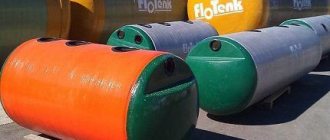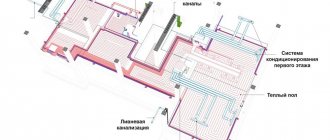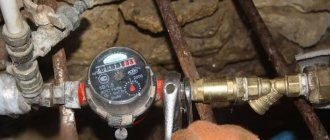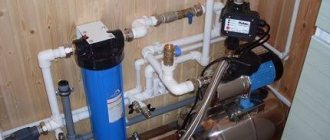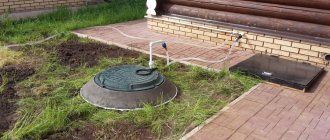Here you will learn:
- What is a surface pump
- Scope and design of surface pumps
- Pros and cons of surface pumps
- Types of surface pumps
- Basic parameters for choosing a pump
- Installation and connection features
Installing a surface pump differs from installing a submersible model. Before installation, it is necessary to prepare the base, purchase inlet and outlet pipes and other materials.
Abyssinian well: what kind of device is it?
An Abyssinian well is a water intake metal or plastic pipe with a diameter of 2.5–4 cm, installed in an aquifer up to 10-15 m deep. At the bottom of the pipe there is a filter and a well tip, the so-called “needle”. A hand pump or a pumping station powered by electricity is installed on top of the pipe.
Nedrabur member FORUMHOUSE
Abyssinka attracts country residents with the opportunity to solve the problem of water supply for their plot, bathhouse, and even their country house of permanent residence without the arrival of heavy equipment.
The productivity of the Abyssinian, depending on the “thickness” of the aquifer, can reach 3–5 m3 per hour.
Pumping station
To ensure that the pump lasts as long as possible, a pumping station is created. The installation pumps water as needed into the storage tank. This allows you to significantly save equipment resources, since the pump will only turn on when the hydraulic accumulator is empty. In addition, frequent switching on of the pumping unit entails high energy consumption. And thanks to the arrangement of a pumping station, it is possible to save resources, money and provide the house with a certain supply of water.
Water supply pumping station
A hydraulic accumulator as part of a pumping unit is a volumetric tank that has a membrane or bulb inside, around which there is a certain level of pressure. That is, the water entering this container is under pressure. The design of the pumping station also includes a pressure switch, which will force the equipment to start and stop on time. And the pressure gauge installed in the system will help you keep track of the pressure level. Connects all the parts into a single organism “five-outlet” - a special fitting with five outlets.
Pumping station with built-in ejector
Prices for a pumping station
pumping station
Advantages of the Abyssinian well
Among the advantages of the Abyssinian well are:
- Relatively cheap: you can make a well yourself, and everything necessary for its construction can be purchased at the nearest construction market;
- High production speed: on average, it takes several hours to install it;
- Simplicity: it can be installed in a limited space (the subfloor of a house, basement or garage is suitable), as well as anywhere on the site;
- Ease of arrangement: no special heavy drilling equipment or access roads for vehicles are required;
- Long Lifespan: A properly constructed Abyssinian plant can provide clean water for many years.
How to make a filter for an Abyssinian well
The longevity of the “needle” largely depends on the chemical characteristics of the aquifer and the efficiency of its filter.
Alextr61
I recommend making a good filter like this: buy a galvanized thick-walled pipe 1.5 m long. Cut threads on both sides. We screw a pointed “needle” tip onto the base of the pipe (it pushes the soil apart) with a diameter 20 mm larger than the diameter of the pipe (the junction of the tip with the pipe can be welded for strength).
You need to retreat 0.5 m from the base of the pipe. We leave this distance for the sump under the sand. Then, every 50 mm, we drill holes with a diameter of 10 mm in a checkerboard pattern. We wrap the section of pipe with holes with stainless wire with a diameter of 1.5 mm. After this, we additionally wind two layers of stainless steel mesh with small-diameter holes.
We do not boil the mesh on top, but secure it with stainless steel clamps. For better filtration, the pipe can be wrapped in geotextile and secured with steel clamps.
If the aquifer contains a large amount of impurities, and the filter of the Abyssinian well is made with technological violations, then it will become silted, which will lead to a decrease in water quality and rapid failure.
At FORUMHOUSE we described in detail how to make a filter for an Abyssinian well and what technical requirements are required for it.
TOP 6 best surface water pumps
| Photo | Name | Rating | Price | |
| #1 | UNIPUMP MH 500C | ⭐ 5 / 5 4 - votes | Find out the price | |
| #2 | UNIPUMP QB 60 | ⭐ 4.95 / 5 2 - votes | Find out the price | |
| #3 | GRUNDFOS MQ 3-35 | ⭐ 4.9 / 5 4 - votes | Find out the price | |
| #4 | KRATON PWP-370 | ⭐ 4.85 / 5 1 - voice | Find out the price | |
| #5 | GILEX JUMBO 60/35 N-K | ⭐ 4.8 / 5 | Find out the price | |
| #6 | SPERONI KPM 50 | ⭐ 4.75 / 5 1 - voice | Find out the price |
Which surface water pump would you choose or recommend?
Take the survey
Disadvantages of the Abyssinian well
For all its advantages, this type of water supply has several disadvantages. The Abyssinian well cannot be installed everywhere - there are areas where it is better not to even mess with the “needle”.
- The Abyssinian well is installed “on sand”. If there are thick layers of clay, limestone and large stones on the site, constructing such a well is impossible or economically infeasible;
- To lift water from it, it is necessary to use a pumping station (it is impossible to install a submersible pump in a small-diameter well). The distance from the top point of the well to the water surface in the pipe should not exceed 8 m, and the “needle” itself can be clogged to 10-15 meters. If the distance to the water surface is more than 8 meters, then you will have to install a pumping station lower, dig a pit in the underground or install a caisson on the street. If the aquifer is located lower (20 meters or more), then the pumping station simply will not be able to lift water from such a depth.
Relay selection
When choosing a hydraulic relay, you are guided by its range in the water supply; the standard value is 1.5 - 3 bar. When connecting using a pressure gauge, adjust it using the adjusting screws. Do the same with the dry-running relay, setting it to turn off the power when the pressure in the line is less than 1.5 bar. If a private house has a high number of floors, then to supply water with the required pressure to the upper floors, the relay is additionally adjusted, increasing the upper and lower response thresholds.
For example, if the height of the rise to the upper floors is 5 meters (1 bar corresponds to 10 meters of vertical water column), then 0.5 bar is added to the upper and lower response limits and the resulting response range is from 2 to 3.5 bar . The brand chosen for water supply at home must have the appropriate pressure range according to the passport.
Rice. 8 Pumping units with floats and electrolytic sensors
Abyssinian well: necessary conditions
Before you get to work constructing a “needle”, you need to understand whether it is suitable for your area. Therefore, first of all, we find out the depth of the aquifer (even in different areas in the vicinity of Moscow, the depth of the aquifer can vary up to 250 meters) and the type of soil.
When choosing a source of water supply, you should focus on existing water intake wells of a similar design located in close proximity to your site. And in their absence - for exploratory drilling and other reliable geophysical survey methods.
To search for water, different methods are used: from dowsing to geodetic maps, which display soils and aquifers.
Wells
The well is one of the most popular types of shallow wells, found everywhere in private yards.
In the old days, the walls of the well were made in the form of a wooden frame, which affected its short service life. Wood of most species is subject to rotting and destruction when exposed to moisture. The only acceptable option that can increase the service life of wooden log houses for well shafts is the use of larch or oak wood. These materials can withstand decades of continuous exposure to water. Nowadays, wells made of reinforced concrete rings with a meter and one and a half meter diameter are popular. The design of the well makes it possible to collect water from the perched water. Shallow springs, unlike wells, can be used only for technical purposes, watering garden beds. This water is not suitable for drinking raw. When the mine is deepened to at least 15 meters, there is a high probability of reaching higher quality water.
The technology for constructing a mine well consists of sequential installation of concrete rings on top of each other.
- The 1st ring is installed on the soil, after which the soil is selected inside. As you excavate, the ring will lower under its own weight.
- The 2nd ring is installed after the 1st is completely immersed. Further excavation allows the next fragment of the well wall to descend evenly.
- Subsequent rings are installed in a similar way until the shaft reaches the aquifer.
- A head is installed on top of the shaft, consisting of one recessed ring and one upper one.
- Around the head at a distance of 0.6 m, soil is selected to a depth of 1 meter from the soil level. The cavity is filled with clay and compacted.
- A blind area is poured on top of the clay and sand.
- A cover is installed to prevent dust and debris from entering.
The main advantage of wells is not only their accessibility and simplicity, but also a good replenishment rate for the extracted volume of water during favorable periods of the year.
Flaws
Wells are not without their drawbacks. These include:
- Time and labor costs.
- Unstable volume during periods of drought.
- The volume of water in wells is usually unstable and seasonal. In spring, the water becomes unsuitable for drinking.
- The well requires regular cleaning. To do this, it is emptied of water and dirt using a pump.
- There is a direct relationship between water quality and the seasons and amount of precipitation.
- Well water must be boiled.
In places where there are floods and floods, swamps, it is not permissible to install wells for drinking water intake.
Abyssinian wells and site features
Much depends on the individual characteristics of the site. So that your efforts and money are not wasted, and the Abyssian well does not remain a useless monument to your carelessness, a number of points should be clarified before constructing it yourself:
- The depth of the aquifer. To do this, you can ask your neighbors about the water level in their wells, and also measure the distance to the water surface. If the depth of the wells does not exceed 12-15 m, and the distance to the water surface is no more than 5-10 meters, then there is a high probability that the “needle” will be able to provide the house with water;
- Estimated water quality. The Abyssinian is a shallow well, and this aquifer may be susceptible to bacterial and chemical contamination. Therefore, it is necessary to find out in advance where septic tanks and sewage pits are located, and whether there are sources of chemical pollution nearby. Sometimes, already at this stage, it is necessary to abandon the construction of a well;
- Proposed location for the “needle” device. It can be installed right in the house, in the technical room, then the pumping station and other equipment will be protected from adverse weather conditions, and the well itself from freezing in winter (if the house has permanent residence). If the well is supposed to be installed on the site, then it is better to locate it close to the house. In this case, to bring water into the house, you will have to manually dig a trench under the main line, installing a caisson or an insulated shelter, which leads to additional expenses;
- Estimated needle debit. It largely depends on the saturation of the aquifer. An indirect sign can be the water level in neighboring wells. You should also find out whether they dry out in the summer.
A good water-bearing formation under the “igloo” is located in a vein with coarse (river) sand.
Nedrabur member FORUMHOUSE
The most advanced design of an Abyssinian well will not save you if the aquifer has poor water yield and low thickness.
If the water yield of the Abyssinian is low, you will have to purchase and install a storage tank for water of 500-1000 liters.
The water yield of an already installed well can be found out this way: we note the time of filling the measuring container and see how long it takes to fill a 10-liter bucket. Without stopping pumping, we repeat the procedure 2-3 more times in 10-15 minutes, and we get the average value - the specific flow rate of the well.
WINTER OPTION WITH INSTALLATION OF METAL CAISSON
A caisson is an underground metal structure (chamber) located directly above the well, welded hermetically to the casing, and performs several functions:
- Protects the wellhead from flooding and pollution by flood waters.
- Protects the system from freezing and makes it possible to operate the well all year round, and not just in the warm season.
- Makes it possible to place equipment (battery tank, control unit and cable and pipe distribution) directly above the well, in the absence of a special room in the house.
- Provides convenient access to equipment for inspection, repair or maintenance.
| When constructing a turnkey well, the caisson neck cover is at least 5 centimeters above the ground. | When constructing a well in winter, the caisson neck is additionally insulated. | When constructing a turnkey well, all water-lifting equipment is installed in the caisson. |
How to make an Abyssinian well yourself: manual methods
There are two main ways to construct an Abyssinian well:
- Plugging a well with a steel "woman".
- Drilling using a small-sized auger.
Auger drilling requires the presence of special and not always accessible equipment, so we will dwell in more detail on manual methods of drilling a well.
Abyssinian well: driving with a steel “woman”
When driving a well with a “woman,” a special metal pig weighing 40-50 kg is put on the pipe, with a hole in the center and two handles on the sides. A “headstock” is attached to the pipe - a special clamp tightened with bolts. The “grandmother”, being a stop for the “woman”, upon impact transfers all the energy to the pipe and the “needle”, which gradually enters the ground. As the pipe moves deeper into the rock, additional elbows are screwed onto the pipe, one after another, through couplings until the “needle” reaches the specified depth.
You can also screw a special nozzle onto the head of the pipe, which will be used to deliver blows. This method of constructing an Abyssinian well is demanding on the quality of the thread, because a lot of pressure falls on her.
Fludik member FORUMHOUSE
I assembled the “igloo” using steel couplings and tow (flax) with paste, because... Cast iron fittings may burst due to impacts. While driving, I constantly tightened the column clockwise with a wrench.
To control the immersion depth of the column and facilitate the passage of soil, water is poured into the pipe.
When the water reaches the aquifer, it leaves the pipe with a characteristic noise. After this, you can add another meter to the column (so that the entire filter is in the water layer) and try to pump the “needle”.
Yuri member of FORUMHOUSE
When water is poured into a pipe, it can go either into the space between the pipe and the clay/dry sand, or into the aquifer. We rock the column with a hand piston pump. And only then we connect the electric one.
Alextr61 member FORUMHOUSE
After driving the Abyssinian, at first I had muddy water with fine sand and suspended matter.
After pumping about 500 liters, the water came out clean. Somewhere after 1000 liters, the water began to be used for drinking.
As the well is pumped and a water lens is washed around the “needle” filter, the water will flow cleaner and purer. We invite you to familiarize yourself with our article, which discusses in detail the construction of an Abyssinian well using the method of driving it with a steel “woman”.
Operating principle of pressure equipment
Ejector-type installations are more powerful.
The station installed on the surface is designed to supply liquid from sources at shallow depths: up to 8–9 meters. Pressure equipment does not need to be immersed in water.
The surface pump works according to this principle:
- The expansion tank or hydraulic accumulator connected to the pump is filled with water to the set level due to the design.
- The automation turns off the pump after the liquid reaches a certain point. Water intake stops.
- When the liquid level in the accumulator drops, the automation turns on the pump and it fills the hydraulic accumulator.
The principle of operation is based on the fact that a vacuum is created in the part of the suction hose that is not lowered into the liquid. Water rises through a conduit due to differences in pressure between its ends.
Installation of the installation itself is not difficult. To do this, you just need to carefully study the attached manual and connect the parts to each other. The installation diagram at the desired location and connection to the well is more complicated.



